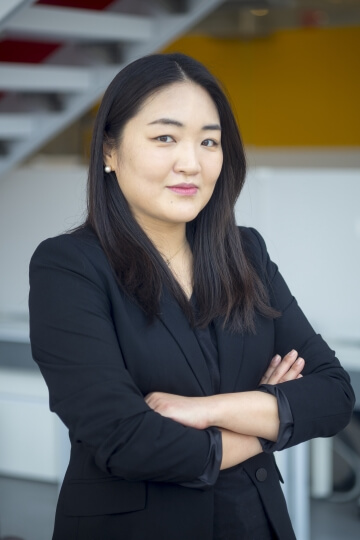SueYeon Chung, S.M., Ph.D. '17
Statistical physics uses activity at the microscopic level to predict visible, macroscopic phenomena. This approach is broadly applicable to understanding a wide range of complex systems, such as how interactions between individual molecules can lead to the laws of thermodynamics that govern the universe, or how the interaction of individual neurons in the brain can lead to complex behavior.
SueYeon Chung, S.M., Ph.D. '17, arrived at the Harvard John A. Paulson School of Engineering and Applied Sciences (SEAS) wanting to use the power of statistical physics to study the human brain. Her approach took advantage of her undergraduate degrees in physics and mathematics from Cornell University, and Chung went on to incorporate physics, mathematics and computer science into her Ph.D. in applied physics.
“It’s a fascinating problem space: trillions of electrical pulses running around in billions of neurons somehow create emergent behavior that enable humans to see, touch, feel and dream,” she said. “The computational theories we developed allow us to analyze activity from thousands of neurons at a time and explain what’s going on in an intuitive way.”
Computational neuroscience has been the focus of Chung’s career in the six years since completing her degree at SEAS. Following postdoctoral positions at MIT and Columbia, she joined New York University as an assistant professor at the start of the 2022-23 school year. She also holds a joint appointment as a principal investigator for the Simons Foundation’s Flatiron Institute Center for Computational Neuroscience.
“I love what I’m doing, and I think I’m quite lucky to find this problem space,” Chung said. “It’s really fun to do theoretical research but also closely interact with experimental groups.”
Growing up in Seoul, South Korea, Chung discovered her love for mathematics early and spent much of her childhood in math competitions. In high school, she became interested in going to college in the United States and was won over by Cornell’s education and campus. After earning her bachelor’s degrees, Chung spent one extra year as a research assistant in a physics lab at Cornell, then came to Harvard in 2010. Her primary Ph.D. advisor was Haim Sompolinsky, Professor of Molecular and Cellular Biology and of Physics in Residence in the Faculty of Arts and Sciences, and her co-advisor was Ryan P. Adams, then-Assistant Professor of Computer Science at SEAS.
“Haim is an expert in neural networks theory and statistical physics, and Ryan is an expert in machine learning with a background in physics,” Chung said. “I got a really solid groundwork and background in the theories of statistical physics and machine learning, and I can now take that and apply it to understand neural data and the fundamentals of computational processing in the brain.”
When it comes to understanding neural data, computational neuroscience can be applied two ways. Computational methods can be used to understand biological brain processes with neural data, or one can create artificial neural networks with biological characteristics that mimic how the brain operates. In this sense, Chung’s research bridges the gap between neuroscience and the rapidly expanding field of artificial intelligence.
“One definition is more theoretical, and the other is more driven by tools and analyses, but it turns out that knowing physics is quite helpful in both,” she said. “I wanted to work in an area where I could talk to an experimentalist to help test my theoretical predictions. The brain is a computing system similar to artificial neural networks, but it’s also an organ in an animal’s body. That duality is very fascinating to me.”
Chung spent her first year at NYU launching her lab while also leading the NeuroAI and Geometry Group at the Flatiron Institute. She’ll begin teaching this fall, when she plans to offer a graduate-level course in computational neuroscience.
“It’ll be a very interdisciplinary course, and a great way to interact with students interested in getting into this field,” she said. “My advisors pushed me to develop a keen eye for finding interesting and truly important problems that both satisfy my curiosity and also impact the community. I always try to have a mindset of both an intellectual and scholar and also a bit of a start-up founder, to do something useful and practical and helpful for the rest of the academic community. I’m trying really hard to nurture that taste in the students and postdocs who are working with me.”
Press Contact
Matt Goisman | mgoisman@g.harvard.edu
